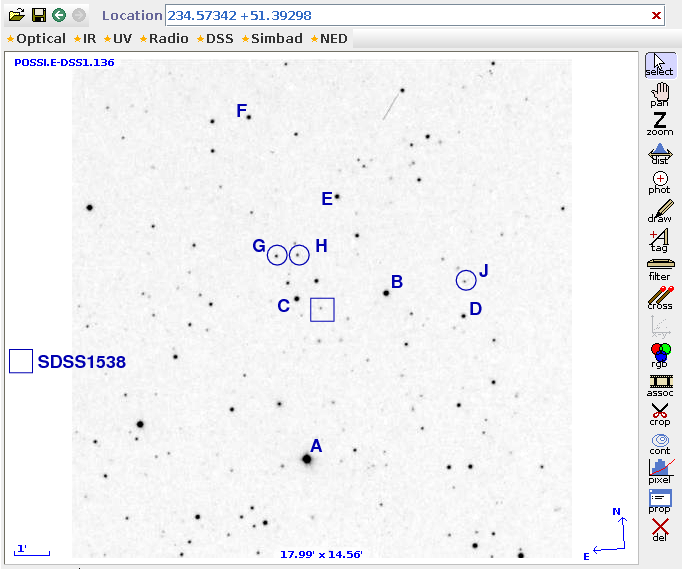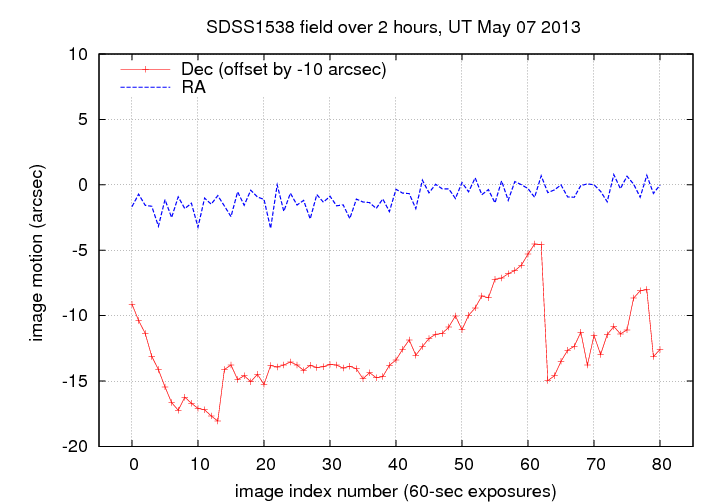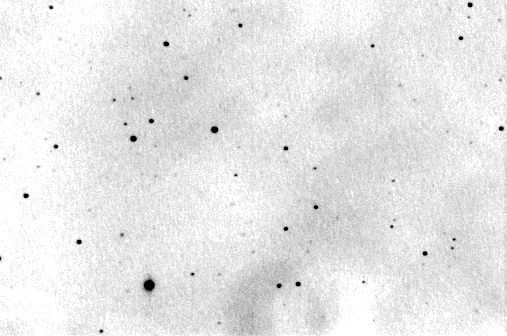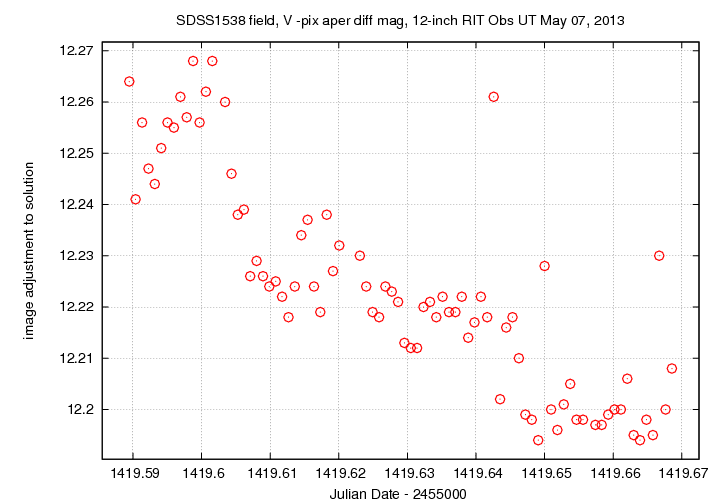
On the night of May 06/07, 2013, I measured the cataclysmic variable known as SDSSJ1538+5123. The Hubble Space Telescope will observe this object later this month (May 16-17), so it's important to monitor its brightness.
The setup was:
Notes from the night
This is a chart of the field of SDSSJ1538, taken from Aladin and the POSS I E plate. The target is in the square box near the middle of the field.

You can find information on the star, including a photometric sequence of comparison stars nearby, at the AAVSO's entry for SDSS1538 in the International Variable Star index.
AUID letter RA. Dec. B V B-V ------------------------------------------------------------------------------------------ 000-BJR-224 A 15:38:51.06 51:20:37.2 13.186 (0.077) 12.617 (0.061) 0.569 (0.098) 000-BJR-225 B 15:38:05.33 51:23:57.9 13.998 (0.006) 13.343 (0.006) 0.655 (0.008) 000-BJR-226 C 15:38:21.62 51:23:55.9 14.756 (0.008) 14.170 (0.008) 0.586 (0.011) 000-BJR-227 E 15:38:13.33 51:26:46.1 15.843 (0.010) 15.082 (0.010) 0.761 (0.014) 000-BJR-228 F 15:38:28.57 51:29:09.1 15.820 (0.004) 15.295 (0.000) 0.525 (0.004) 000-BJR-229 D 15:37:51.56 51:23:10.8 16.732 (0.017) 15.691 (0.017) 1.041 (0.024) 000-BJR-230 15:38:37.21 51:23:54.9 16.670 (0.010) 16.161 (0.008) 0.509 (0.013) 000-BJR-231 15:37:58.24 51:27:07.2 17.283 (0.011) 16.443 (0.008) 0.840 (0.014) 000-BJR-232 15:38:39.75 51:25:36.2 17.897 (0.022) 17.117 (0.011) 0.780 (0.025) 000-BJR-233 G 15:38:24.80 51:25:11 18.194 (0.036) 17.360 (0.008) 0.834 (0.037) 000-BJR-234 H 15:38:21.08 51:25:10.8 18.777 (0.047) 17.864 (0.000) 0.913 (0.047) 000-BJR-235 J 15:37:50.99 51:24:10.5 18.951 (0.025) 18.265 (0.008) 0.686 (0.026) ------------------------------------------------------------------------------------------ Report this sequence as: 11711AGH in the chart field of your observation report.The brightest star, marked "Q", is UCAC4-707-053459, and has magnitude V = 10.77. The target, SDSS1538, is much fainter, with a magnitude in quiescence of roughly V = 18.
Tonight, I planned to acquire images with only the V-band filter. I took twilight sky flats.
I again guided the telescope using a nearby star. As explained in the notes from last night , the telescope doesn't move smoothly in Dec, so a few exposures suffered from jumps. I discarded those -- they amounted to just a few percent of the total. The graph below shows the motion of stars in the field over the course of the observations; about two hours of looking at the same field. Note the good performance in RA, and the relatively few jumps in Dec.

I took one series of images: V-band images with 60-second exposure time. I discarded just 2 of the 84 images, leaving a set of 82 good pictures.
Stack of (82 x 60 seconds) with V filter.

Using aperture photometry with a radius of 4 pixels (radius of 7.4 arcsec), I measured the instrumental magnitudes of a number of reference stars and the target. I ran ensemble photometry on the dataset, to check the quality of the night. The graph below shows the change in zeropoint from image to image. Note the small scatter and gradual change: that indicates a lack of clouds and a decreasing airmass. A quick and dirty linear fit yields an extinction coefficient of 0.35 mag/airmass, which is reasonable for the V filter. Two of the three outliers at late times are due to elongated images, due to slight trailing.

There are two ways to estimate the magnitude of SDSS 1538.
V = (instr. V mag) - 1.45 +/- 0.03 mag
from which we can derive
SDSS 1538 V = 18.4
V = (instr.V mag) - 1.37 - 0.098 * (B-V) +/- 0.02
from which we can derive
SDSS 1538 V = 18.5
I'm going to conclude that V = 18.5 +/- 0.4. The large uncertainty is due to the low signal-to-noise value for SDSS 1538 in these images.
Let me summarize my results:
# Measurements of SDSS 1538+5123 # made by Michael Richmond at the RIT Observatory # with 12-inch Meade LX200 + SBIG ST-8E CCD. # V filter, stacked (82 x 60-second) exposure # Conditions were fair: dark skies with a light haze. # # Aperture photometry with radius 4 pix = 7.4 arcsec. # Reference star photometry from AAVSO chart 11713LT # "V" mag is based on V-band measurements, # compared to V-band reference magnitudes, (B-V) color terms. # # UT Date mid-UT JD V mag #---------------------------------------------- 2013 May 07 03:05 2456419.63 18.5 +/- 0.4
Last modified 05/07/2013 by MWR.